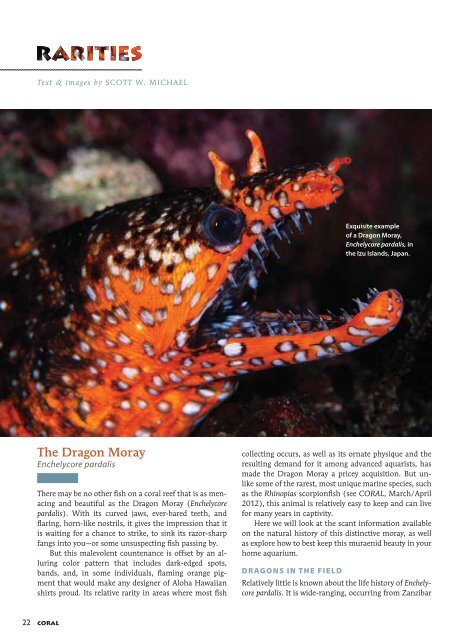Create successful ePaper yourself
Turn your PDF publications into a flip-book with our unique Google optimized e-Paper software.
Text & images by SCOTT W. MICHAEL<br />
Exquisite example<br />
of a Dragon Moray,<br />
Enchelycore pardalis, in<br />
the Izu Islands, Japan.<br />
The Dragon Moray<br />
Enchelycore pardalis<br />
There may be no other fish on a coral reef that is as menacing<br />
and beautiful as the Dragon Moray (Enchelycore<br />
pardalis). With its curved jaws, ever-bared teeth, and<br />
flaring, horn-like nostrils, it gives the impression that it<br />
is waiting for a chance to strike, to sink its razor-sharp<br />
fangs into you—or some unsuspecting fish passing by.<br />
But this malevolent countenance is offset by an alluring<br />
color pattern that includes dark-edged spots,<br />
bands, and, in some individuals, flaming orange pigment<br />
that would make any designer of Aloha Hawaiian<br />
shirts proud. Its relative rarity in areas where most fish<br />
collecting occurs, as well as its ornate physique and the<br />
resulting demand for it among advanced aquarists, has<br />
made the Dragon Moray a pricey acquisition. But unlike<br />
some of the rarest, most unique marine species, such<br />
as the Rhinopias scorpionfish (see CORAL, March/April<br />
2012), this animal is relatively easy to keep and can live<br />
for many years in captivity.<br />
Here we will look at the scant information available<br />
on the natural history of this distinctive moray, as well<br />
as explore how to best keep this muraenid beauty in your<br />
home aquarium.<br />
DRAGONS IN THE FIELD<br />
Relatively little is known about the life history of Enchelycore<br />
pardalis. It is wide-ranging, occurring from Zanzibar<br />
22 CORAL

















